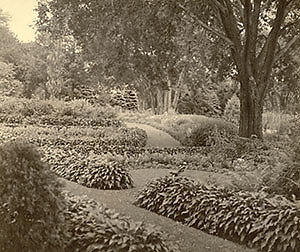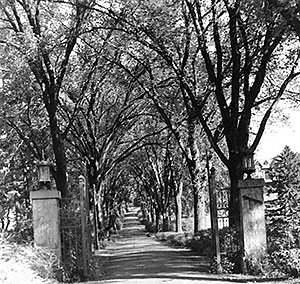
The Halls used Brucemore and its grounds in different ways than their predecessors. The landscape served more as a background for their lives and reflected the fact that they were a childless couple who engaged in fewer activities on the grounds of the estate. They sold off several acres to the north adjacent to the First Avenue driveway and several acres bordering Forest Drive. This reduced the 33-acre estate to its present size of 26 acres.
Overall, the diversity of the landscape functions diminished while the Halls lived on the property. A modernist influence impacted the look of the Formal Garden. A reduction in the variety of flowering species led to a concentration of bold colors. Rows of roses and peonies, although considered “old fashioned,” were important in Margaret’s simplified scheme. Specialty gardens were no longer popular, and at some point, the Douglas Night Garden was removed. Sections of the grape arbor were torn down, opening the view of the garden from the mansion. They eliminated the Tennis Court around 1937.
Agricultural-related activities, so important to the early twentieth-century country estate, were reduced in number and scope. The vegetable garden remained but at a reduced scale. The orchard was retained, although it was relocated after the Douglas trees were decimated by cold weather in 1942.

Margaret and Howard continued to raise chickens and ducks, also importing a population of Australian swans to make their home on the pond. The Halls enjoyed spending time by the pond. In addition to having an island constructed for their swans, they had a stone patio and stone picnic table built at the west end.
The most dramatic change during the Hall era was not intentional. The Sinclair and Douglas visions of gracious, elm-lined drives were fully realized during this time in the allées off First Avenue and the driveway off Linden.
The mature trees that dotted the estate gave portions of the property a park-like appearance. An estimated 80 trees succumbed to a severe windstorm that swept through Cedar Rapids in 1962 and dozens of elms fell to Dutch elm disease in the 1960s.